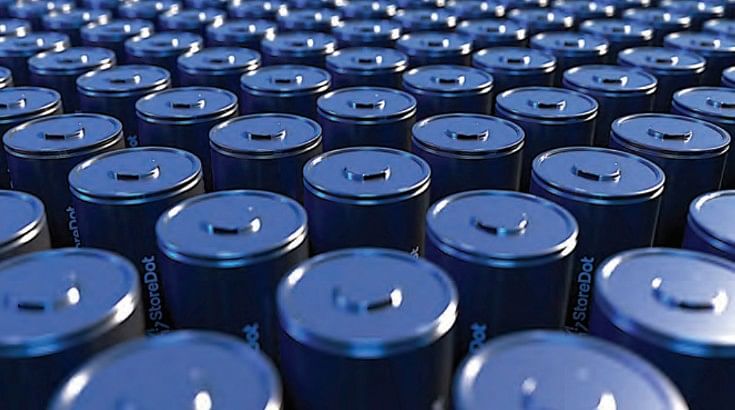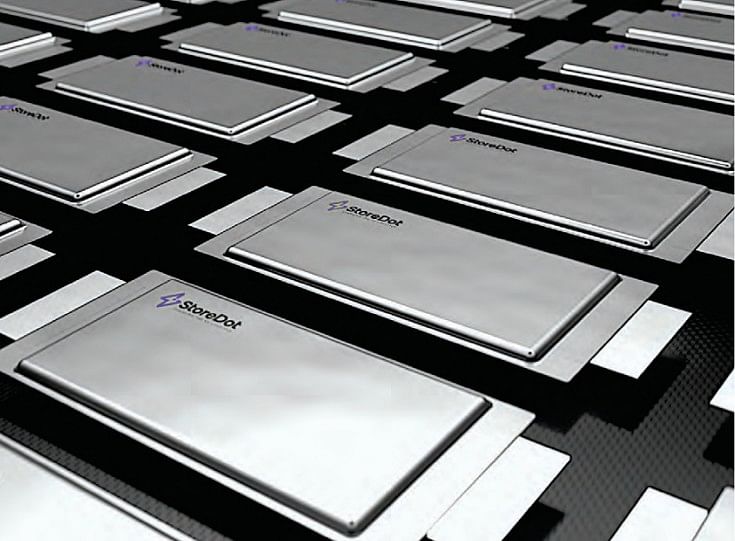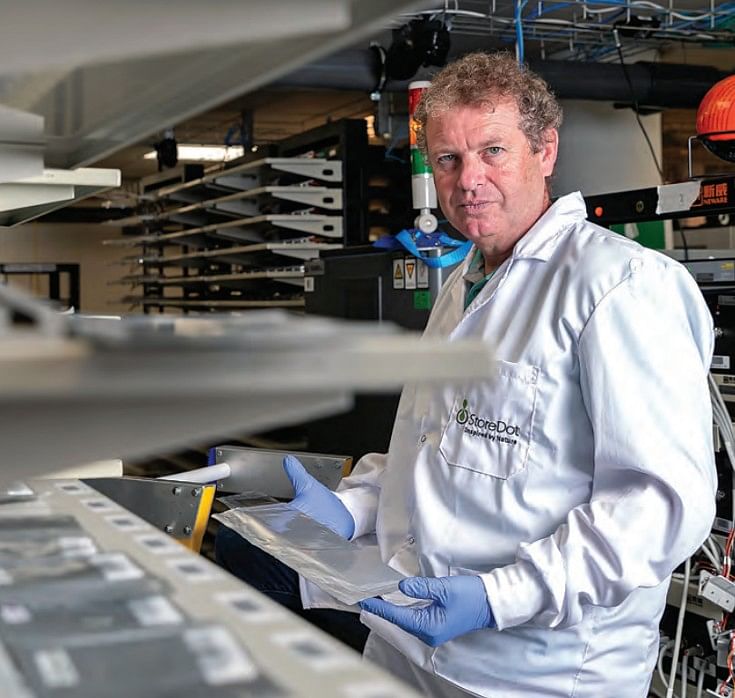Doron Myersdorf: Our focus is on Ola’s future products
The founder and CEO of StoreDot, the Israel-based extreme fast-charging battery company, speaks about partnering with Ola, India as a manufacturing base, key learnings from global markets, and why battery swapping will complement fast-charging tech.
What is Ola Electric’s investment in StoreDot?
The investment was part of our Series D round, that in total comes to around $80 million (approximately Rs 610 crore). While we do not give the internal breakdown, what is important is that we have signed a strategic collaboration agreement, regardless of the equity component. StoreDot is already a high-valued company where it is difficult to acquire a lot of equity. Our aim is to grab a significant market share of a fast-charging batteries in India through this collaboration in the coming years. As far as investment goes, Ola is the only Indian company and one of the five companies globally, which participated in our Series D round. The others include VinFast from Vietnam, bp Ventures and China’s EVE Energy, among others. Till date, we have raised $200 million (approximately Rs 1,532 crore).
So far you indicated that two- and three-wheelers were not on the top of your priority list. If you could explain the rationale for the collaboration with Ola Electric in that perspective?
I think it is an alignment of our vision. India in the EV space is a bit behind in terms in the passenger vehicle segment. If we want to achieve significant marketshare in the fourwheeler space, we need to start as early as possible with partners who share our vision such as Ola Electric. Currently, we are starting with the two-wheeler segment which is the requirement for the Indian market. Ola has already begun to design four-wheelers and these will be on the roads in the future. At that time, we will align with the roadmap.
Will StoreDot provide batteries for Ola’s two and four-wheeler EVs?
We will because one needs to understand that the optimisation of the battery chemistry is key. Fast charging is important both for two- and four-wheelers. Initially, we had optimised the chemistry for four-wheelers. But now for two-wheelers, we need to have the right form factor which might be a cylindrical cell that we have also been working on or smaller pouches. We already have samples so it’s only a matter of the application and the implementation of the chemistry in two-wheelers. For us, this is a steppingstone, to reach the Holy Grail which is a full vehicle that charges in minutes. Having said that, our focus is on Ola’s future generations/products. Starting 2023, there will be different designs optimised for cooling. As far as the different battery chemistry for India and two-wheelers goes, it is a silicon-based anode in this current generation battery. We are using the same chemistry but the form factor is important so the packaging or scooter, and that will constitute a different solution. So we have the 21700 cell that can be used.

When will StoreDot's first battery debut in a vehicle in India?
It depends on where it will be manufactured and the timeline of the ramping up of Ola Electric facility. Potentially we will begin production in China in 2023 for Ola, it would probably be 2024. Also, we are open to importing the batteries initially from China. Also, given that our agreement with Ola is exclusive for India, any partnerships we enter into will be through Ola.
Ola Electric has qualified for the PLI in Advanced Battery Chemistry so would you look at India as a manufacturing and export hub?
It is an absolute possibility but will take 2-3 years to build a facility and then a year for volume production. So we are talking of a timeline around 2025-2026. The scenario that might come into play is of a major shortage of batteries worldwide. The market is going to go into significant over demand for batteries and any partnership that would enable us secure capacity is important. At that point, these batteries could come from anywhere. Having said that, we can actually deliver our XFC technology to our partners such as Daimler or VinFast.
Could Ola Electric become a potential battery supplier / contract manufacturer for other players?
This is an absolute yes because the business model is a mixed model between captive capacity and any overflow of demand would be through licensing. Ola would have this license and it would be able to give this to other India-based players.
Will StoreDot also make investments in the manufacturing facility in India?
Our business model includes participation in the manufacturing facility. But this would have to be after our next round of funding. Our current funding is sufficient for the next three years of R&D. But in order to own captive capacity, we would need roughly $300 to $400 million (approximately Rs 2,288 crore to Rs 3,051 crore) in about two years or so
StoreDot launched the sample of the first generation of extreme fast charging (XFC) batteries last year. What have been the key learnings?
The key challenge is to reach a sufficient charge/ discharge cycle for the XFC batteries. We have just achieved 1,200 number of consecutive fast-charging cycles. Our goal has been to achieve this critical milestone of consecutive extreme fast charging cycles. The results show consistent performance which is good. Once you pass the 1,000 cycle, it is already sufficient for vehicle warranty. That is because one cycle provides around 300 miles (482km) of range, and if one has a 1,000 cycle it's a warranty for 300,000 miles of the vehicle. We are talking about more than 1,000 fast charge cycles, each being more than 400km, which means nearly half a million kilometres. All this really depends on battery design and vehicle. This was originally designed for passenger vehicles, for instance, a Tesla, not necessarily for scooters. But the battery chemistry can also work in the two- and three-wheeler segment. The challenge here was to optimise the chemistry that would daily be used as an extreme fast charger. If one comes to a high-power charging station, let's say in a vehicle, we are talking about 350 kW charging station, which is a very powerful EV charger, but a normal battery cannot take all this energy because of resistance, and heat and safety issues. We have developed a battery that is safe and can sustain more than 1,000 extreme fast charging cycles all the time. This is a breakthrough because in normal graphite based batteries, one cannot do the same. The battery will be dead in 1 or 2 of these extreme cycles. We are talking about more than 1,000 times, and charging a battery completely in under 10 minutes.

Will the battery life cycle further increase if people do not fast charge it?
We are talking about the extreme fast charging wherein the consumer is always using the rapid charge on the go. We are optimising for that scenario, which was considered impossible to do. That is why it is a big news that StoreDot’s battery chemistry allows for consecutive extreme fast-charge cycles.
Of the various patents that you have can you explain to us about the optimal deception of heat which is emitted during the ultrafast charge?
We have over 100 patents now and these are specifically about the dissipation focused on the cylindrical cell and the ability to dissipate the heat also from the centre of the cylinder, and not only from the outer perimeter. It basically is a design of the cylindrical cell optimised for heat dissipation. One can think about it, for example, like a hole in the centre, which is a void, and where you can place the cylinder or let's say a cooling rod. The hole acts as vehicle to extract the heat. And it comes directly out of the centre of the cylinder as opposed to trying to pull everything from the outside.
How would the ongoing global supply chain issues and the geopolitical situation — the war in Ukraine and the fact that China controls a vast majority of lithium reserves — impact manufacturing?
There is an impact, and this is something that all the other battery manufacturers are facing. The number one concern is around the supply of cathode materials like nickel, manganese and cobalt that we also currently use. There is a temporary price hike for these materials but I think we will see over time the compensation for this. If one looks at what is happening to the price of batteries, there is a 5-7 percent decline on an average per annum over a 10 to 15-year horizon. Having said that 2022 is going to be a stressful. But we are not in mass production yet. Assuming that this war could end in the foreseeable future, we are going to mass production next year. It will then be back to the normal cost reduction curve.

What are the other battery chemistries that you are exploring?
The number one alternative is to use LFP or Lithium iron phosphate battery chemistry, and we have already started investigating the implications of using it as opposed to NMC or Lithium Nickel Manganese Cobalt Oxide batteries in the cathode. The first or the most concerning impact is that you lose about 20 to 30 percent of the energy of the range of the vehicle. We are looking for innovative ways to compensate for this loss, either through what it is called the cell-to-pack design, meaning building larger cells and less modules and utilising less overheads in the vehicle. That will lead to more efficiency by implementing the LFP technology. We are also trying to optimise the silicone anode that has higher energy so it would also compensate for some of the LFP limitations. In China and also for Tesla, the focus is on LFP. In my view, this is a temporary trend because of the supply chain stress we are currently undergoing. As we move to 2024-2025, I think NMC will be the winning solution because it provides much better energy efficiency.
Given instances of e-scooters catching fire, how do you plan to ensure safety of batteries?
This is an engineering challenge, much less a chemistry challenge. Our battery chemistry can sustain 50 degree ambient temperature and we need to make sure that during charging there is also some air-cooling that would make sure that battery temperature does not go above say 45 or 50 degree. We had demonstrated even back in 2019 that the five-minute charging of the scooter with some air-cooling using just fans. We repeated that later at a live event in London. But, of course, there would need to be some work on the design of the scooter so that there is sufficient cooling not only during charging but also during vehicle operation. This is a challenge for any type of battery that one would introduce. We would work with Ola on this as well as you know it has to be resolved as a system solution, not battery solution.
India’s two- and three-wheeler segment is seeing a lot of traction in terms of alternatives that facilitate battery swapping. What is your perspective?
Battery swapping makes a lot of sense and it is a complementary solution to fast charging. Basically, it is another mechanism to achieve the same end-result, which is, you know in 5 minutes one can be on the road, so the experience of the EV user is exactly like refuelling. We would find, depending on the deployment of infrastructure in different areas, that there will be a mix of solutions. Some of them will be with high power charging stations and some with swapping. Which will predominate depends on the investment in the infrastructure in each location. The Indian market has a very significant growth opportunity and there is room for a variety of solutions. Battery swapping is a market maker providing flexibility and the diverse charging solutions. These solutions will actually increase the adoption of electric vehicles. In fact, it (battery swap) has been there for at least 10 years even in Israel, and it actually paved the way for a lot of thinking and how to implement fast charging. It is a complementary or add on solution.
This interview was first published in Autocar Professional's April 1, 2022 issue.
RELATED ARTICLES
'No Question of Us Being Late' - Suzuki India on e-2Wheeler Market
Suzuki Motorcycle India believes its EV entry is timely as the market is now mature enough to grow off genuine demand ra...
'India Can Become a Major Pillar for Us' - Marquardt Group
Björn Twiehaus, CEO of Marquardt Group, and Vishal Narvekar, the company's India GM, share their outlook on the Indian m...
Luxury Car Market to Slow in 2025: Mercedes-Benz Sees Flattish Numbers
In Jan to March of 2025, the market may witness its slowest growth since COVID-19, and if the weakness continues, the se...





 04 Apr 2022
04 Apr 2022
 4893 Views
4893 Views





 Angitha Suresh
Angitha Suresh


 Darshan Nakhwa
Darshan Nakhwa

 Prerna Lidhoo
Prerna Lidhoo

